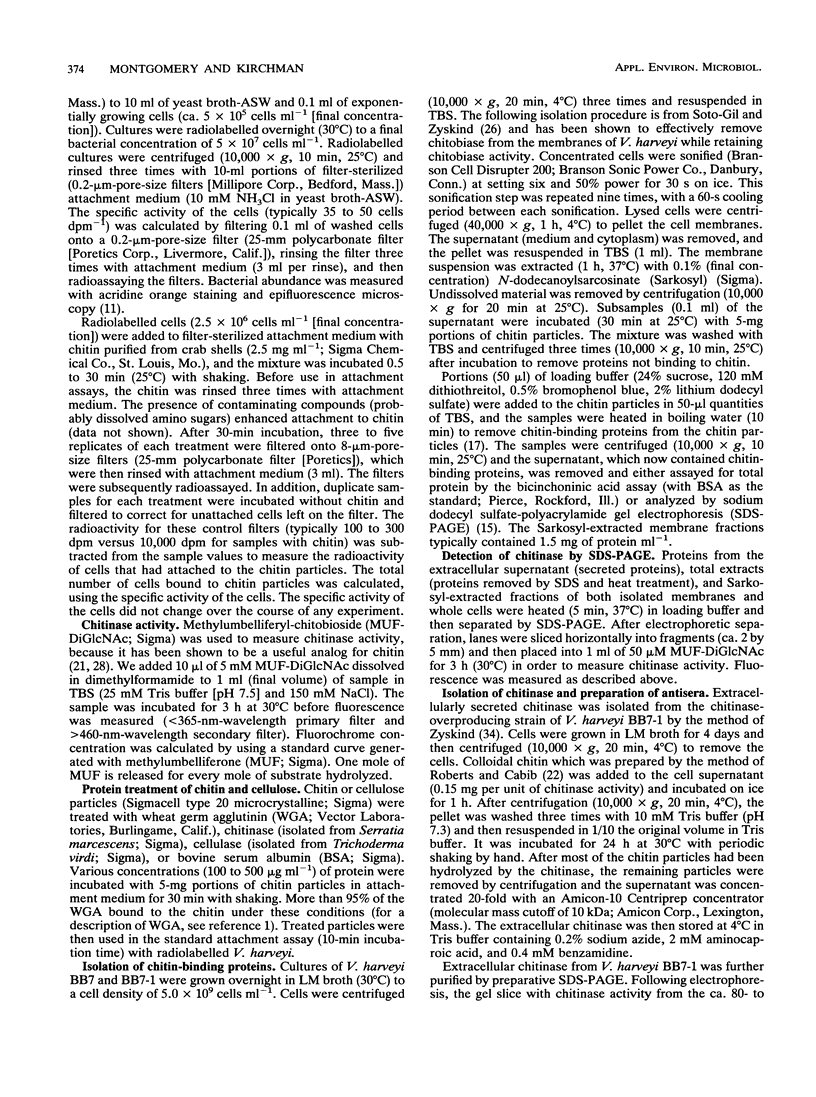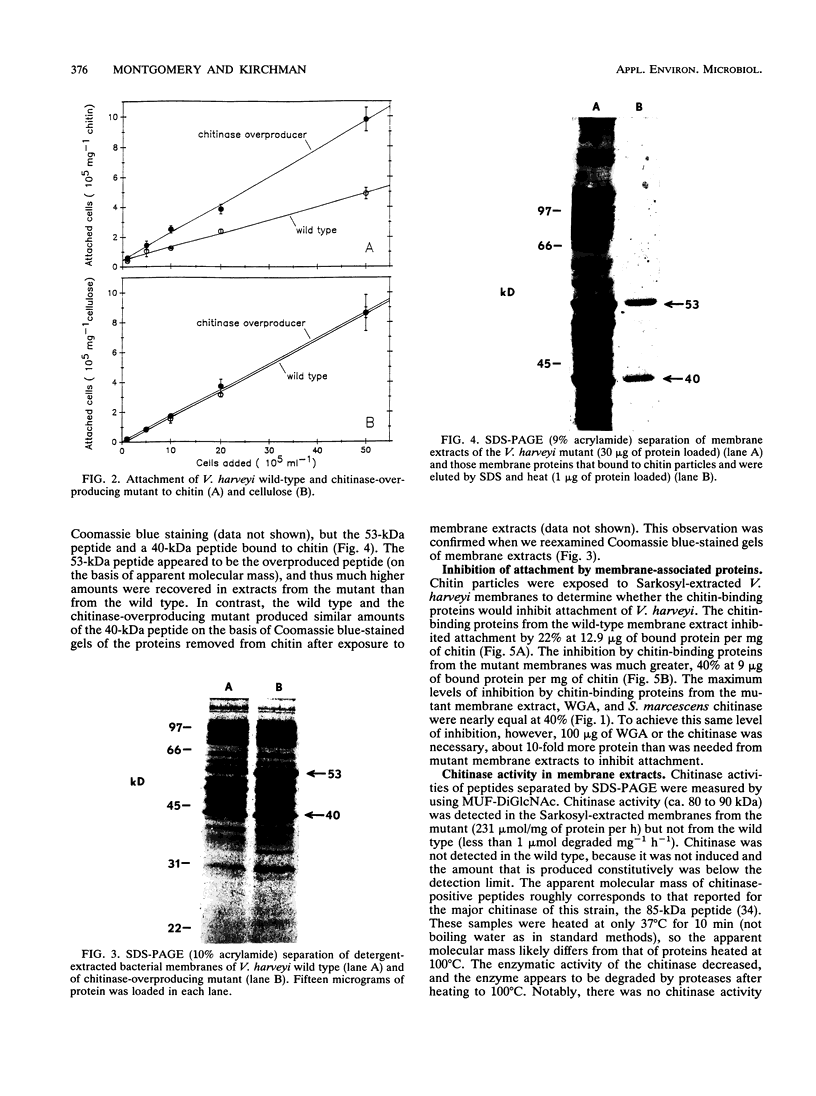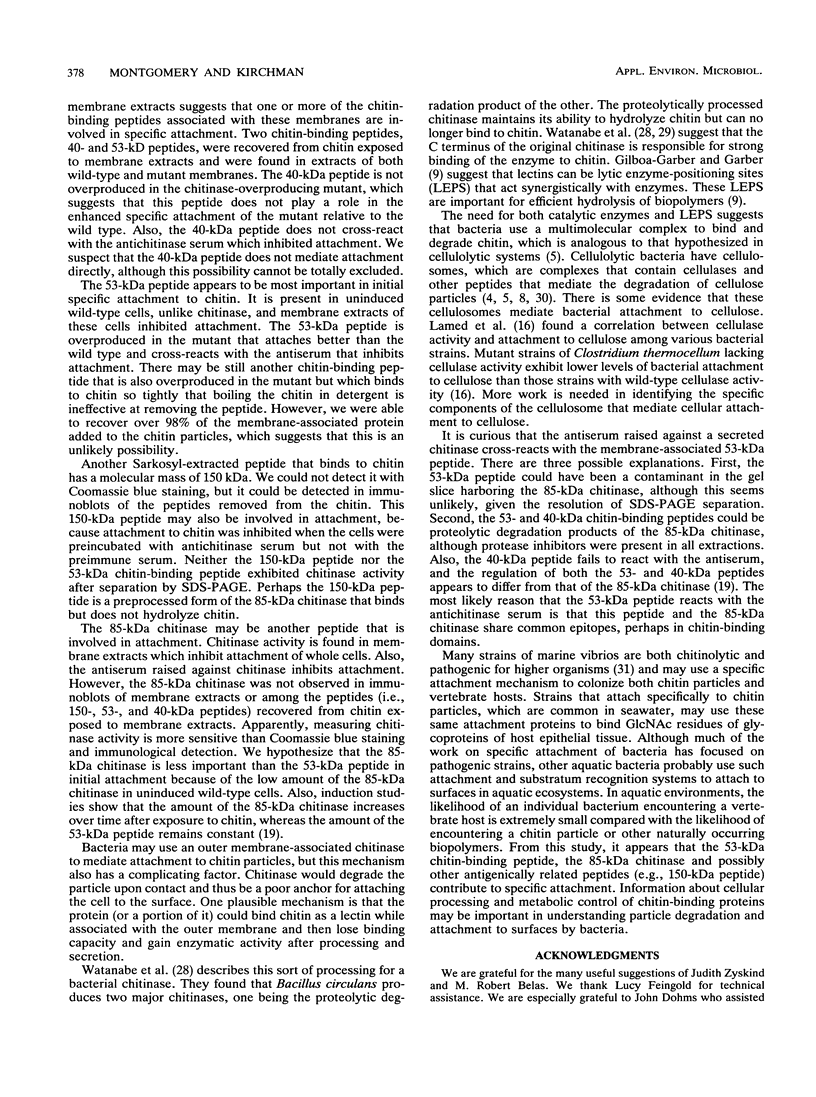Abstract
We examined the mechanism of attachment of the marine bacterium Vibrio harveyi to chitin. Wheat germ agglutinin and chitinase bind to chitin and competitively inhibited the attachment of V. harveyi to chitin, but not to cellulose. Bovine serum albumin and cellulase do not bind to chitin and had no effect on bacterial attachment to chitin. These data suggest that this bacterium recognizes specific attachment sites on the chitin particle. The level of attachment of a chitinase-overproducing mutant of V. harveyi to chitin was about twice as much as that of the uninduced wild type. Detergent-extracted cell membranes inhibited attachment and contained a 53-kDa peptide that was overproduced by the chitinase-overproducing mutant. Three peptides (40, 53, and 150 kDa) were recovered from chitin which had been exposed to membrane extracts. Polyclonal antibodies raised against extracellular chitinase cross-reacted with the 53- and 150-kDa chitin-binding peptides and inhibited attachment, probably by sterically hindering interactions between the chitin-binding peptides and chitin. The 53- and 150-kDa chitin-binding peptides did not have chitinase activity. These results suggest that chitin-binding peptides, especially the 53-kDa chitin-binding peptide and chitinase and perhaps the 150-kDa peptide, mediate the specific attachment of V. harveyi to chitin.
Full text
PDF






Images in this article
Selected References
These references are in PubMed. This may not be the complete list of references from this article.
- Allen A. K., Neuberger A., Sharon N. The purification, composition and specificity of wheat-germ agglutinin. Biochem J. 1973 Jan;131(1):155–162. doi: 10.1042/bj1310155. [DOI] [PMC free article] [PubMed] [Google Scholar]
- Anderson K. L., Salyers A. A. Biochemical evidence that starch breakdown by Bacteroides thetaiotaomicron involves outer membrane starch-binding sites and periplasmic starch-degrading enzymes. J Bacteriol. 1989 Jun;171(6):3192–3198. doi: 10.1128/jb.171.6.3192-3198.1989. [DOI] [PMC free article] [PubMed] [Google Scholar]
- Anderson K. L., Salyers A. A. Genetic evidence that outer membrane binding of starch is required for starch utilization by Bacteroides thetaiotaomicron. J Bacteriol. 1989 Jun;171(6):3199–3204. doi: 10.1128/jb.171.6.3199-3204.1989. [DOI] [PMC free article] [PubMed] [Google Scholar]
- BERGER L. R., REYNOLDS D. M. The chitinase system of a strain of Streptomyces griseus. Biochim Biophys Acta. 1958 Sep;29(3):522–534. doi: 10.1016/0006-3002(58)90008-8. [DOI] [PubMed] [Google Scholar]
- Bayer E. A., Lamed R. Ultrastructure of the cell surface cellulosome of Clostridium thermocellum and its interaction with cellulose. J Bacteriol. 1986 Sep;167(3):828–836. doi: 10.1128/jb.167.3.828-836.1986. [DOI] [PMC free article] [PubMed] [Google Scholar]
- Belas R., Mileham A., Simon M., Silverman M. Transposon mutagenesis of marine Vibrio spp. J Bacteriol. 1984 Jun;158(3):890–896. doi: 10.1128/jb.158.3.890-896.1984. [DOI] [PMC free article] [PubMed] [Google Scholar]
- Béguin P. Molecular biology of cellulose degradation. Annu Rev Microbiol. 1990;44:219–248. doi: 10.1146/annurev.mi.44.100190.001251. [DOI] [PubMed] [Google Scholar]
- Forsberg C. W., Beveridge T. J., Hellstrom A. Cellulase and Xylanase Release from Bacteroides succinogenes and Its Importance in the Rumen Environment. Appl Environ Microbiol. 1981 Nov;42(5):886–896. doi: 10.1128/aem.42.5.886-896.1981. [DOI] [PMC free article] [PubMed] [Google Scholar]
- Gilboa-Garber N., Garber N. Microbial lectin cofunction with lytic activities as a model for a general basic lectin role. FEMS Microbiol Rev. 1989 Sep;5(3):211–221. doi: 10.1111/j.1574-6968.1989.tb03397.x. [DOI] [PubMed] [Google Scholar]
- Glorioso J. C., Jones G. W., Rush H. G., Pentler L. J., Darif C. A., Coward J. E. Adhesion of type A Pasteurella mulocida to rabbit pharyngeal cells and its possible role in rabbit respiratory tract infections. Infect Immun. 1982 Mar;35(3):1103–1109. doi: 10.1128/iai.35.3.1103-1109.1982. [DOI] [PMC free article] [PubMed] [Google Scholar]
- Hobbie J. E., Daley R. J., Jasper S. Use of nuclepore filters for counting bacteria by fluorescence microscopy. Appl Environ Microbiol. 1977 May;33(5):1225–1228. doi: 10.1128/aem.33.5.1225-1228.1977. [DOI] [PMC free article] [PubMed] [Google Scholar]
- Imam S. H., Greene R. V., Griffin H. L. Adhesive properties of a symbiotic bacterium from a wood-boring marine shipworm. Appl Environ Microbiol. 1990 May;56(5):1317–1322. doi: 10.1128/aem.56.5.1317-1322.1990. [DOI] [PMC free article] [PubMed] [Google Scholar]
- Jannatipour M., Soto-Gil R. W., Childers L. C., Zyskind J. W. Translocation of Vibrio harveyi N,N'-diacetylchitobiase to the outer membrane of Escherichia coli. J Bacteriol. 1987 Aug;169(8):3785–3791. doi: 10.1128/jb.169.8.3785-3791.1987. [DOI] [PMC free article] [PubMed] [Google Scholar]
- Laemmli U. K. Cleavage of structural proteins during the assembly of the head of bacteriophage T4. Nature. 1970 Aug 15;227(5259):680–685. doi: 10.1038/227680a0. [DOI] [PubMed] [Google Scholar]
- Lamed R., Naimark J., Morgenstern E., Bayer E. A. Specialized cell surface structures in cellulolytic bacteria. J Bacteriol. 1987 Aug;169(8):3792–3800. doi: 10.1128/jb.169.8.3792-3800.1987. [DOI] [PMC free article] [PubMed] [Google Scholar]
- McGavin M., Forsberg C. W. Catalytic and substrate-binding domains of endoglucanase 2 from Bacteroides succinogenes. J Bacteriol. 1989 Jun;171(6):3310–3315. doi: 10.1128/jb.171.6.3310-3315.1989. [DOI] [PMC free article] [PubMed] [Google Scholar]
- O'Brien M., Colwell R. R. A rapid test for chitinase activity that uses 4-methylumbelliferyl-N-acetyl-beta-D-glucosaminide. Appl Environ Microbiol. 1987 Jul;53(7):1718–1720. doi: 10.1128/aem.53.7.1718-1720.1987. [DOI] [PMC free article] [PubMed] [Google Scholar]
- Roberts R. L., Cabib E. Serratia marcescens chitinase: one-step purification and use for the determination of chitin. Anal Biochem. 1982 Dec;127(2):402–412. doi: 10.1016/0003-2697(82)90194-4. [DOI] [PubMed] [Google Scholar]
- Samuelsson M. O., Kirchman D. L. Degradation of adsorbed protein by attached bacteria in relationship to surface hydrophobicity. Appl Environ Microbiol. 1990 Dec;56(12):3643–3648. doi: 10.1128/aem.56.12.3643-3648.1990. [DOI] [PMC free article] [PubMed] [Google Scholar]
- Sharon N., Lis H. Lectins as cell recognition molecules. Science. 1989 Oct 13;246(4927):227–234. doi: 10.1126/science.2552581. [DOI] [PubMed] [Google Scholar]
- Soto-Gil R. W., Zyskind J. W. N,N'-diacetylchitobiase of Vibrio harveyi. Primary structure, processing, and evolutionary relationships. J Biol Chem. 1989 Sep 5;264(25):14778–14783. [PubMed] [Google Scholar]
- Towbin H., Staehelin T., Gordon J. Electrophoretic transfer of proteins from polyacrylamide gels to nitrocellulose sheets: procedure and some applications. Proc Natl Acad Sci U S A. 1979 Sep;76(9):4350–4354. doi: 10.1073/pnas.76.9.4350. [DOI] [PMC free article] [PubMed] [Google Scholar]
- Watanabe T., Oyanagi W., Suzuki K., Tanaka H. Chitinase system of Bacillus circulans WL-12 and importance of chitinase A1 in chitin degradation. J Bacteriol. 1990 Jul;172(7):4017–4022. doi: 10.1128/jb.172.7.4017-4022.1990. [DOI] [PMC free article] [PubMed] [Google Scholar]
- Watanabe T., Suzuki K., Oyanagi W., Ohnishi K., Tanaka H. Gene cloning of chitinase A1 from Bacillus circulans WL-12 revealed its evolutionary relationship to Serratia chitinase and to the type III homology units of fibronectin. J Biol Chem. 1990 Sep 15;265(26):15659–15665. [PubMed] [Google Scholar]
- Wood T. M., Wilson C. A., Stewart C. S. Preparation of the cellulase from the cellulolytic anaerobic rumen bacterium Ruminococcus albus and its release from the bacterial cell wall. Biochem J. 1982 Jul 1;205(1):129–137. doi: 10.1042/bj2050129. [DOI] [PMC free article] [PubMed] [Google Scholar]
- Wortman A. T., Somerville C. C., Colwell R. R. Chitinase determinants of Vibrio vulnificus: gene cloning and applications of a chitinase probe. Appl Environ Microbiol. 1986 Jul;52(1):142–145. doi: 10.1128/aem.52.1.142-145.1986. [DOI] [PMC free article] [PubMed] [Google Scholar]
- Yamazaki Y., Ebisu S., Okada H. Eikenella corrodens adherence to human buccal epithelial cells. Infect Immun. 1981 Jan;31(1):21–27. doi: 10.1128/iai.31.1.21-27.1981. [DOI] [PMC free article] [PubMed] [Google Scholar]
- Yu C., Lee A. M., Roseman S. The sugar-specific adhesion/deadhesion apparatus of the marine bacterium Vibrio furnissii is a sensorium that continuously monitors nutrient levels in the environment. Biochem Biophys Res Commun. 1987 Nov 30;149(1):86–92. doi: 10.1016/0006-291x(87)91608-1. [DOI] [PubMed] [Google Scholar]





